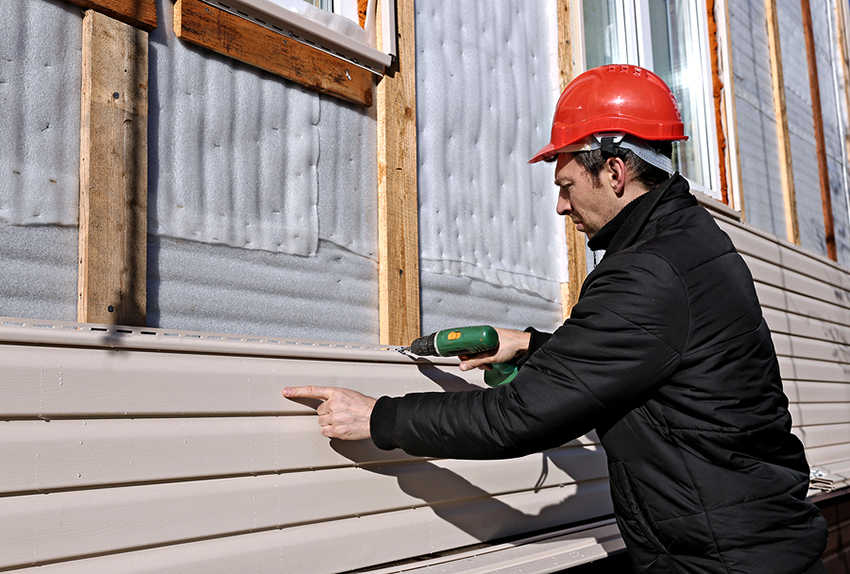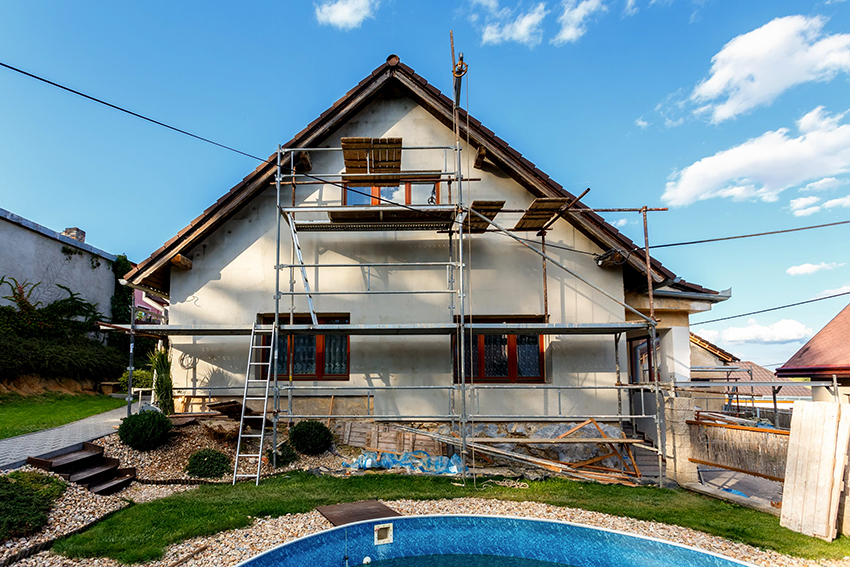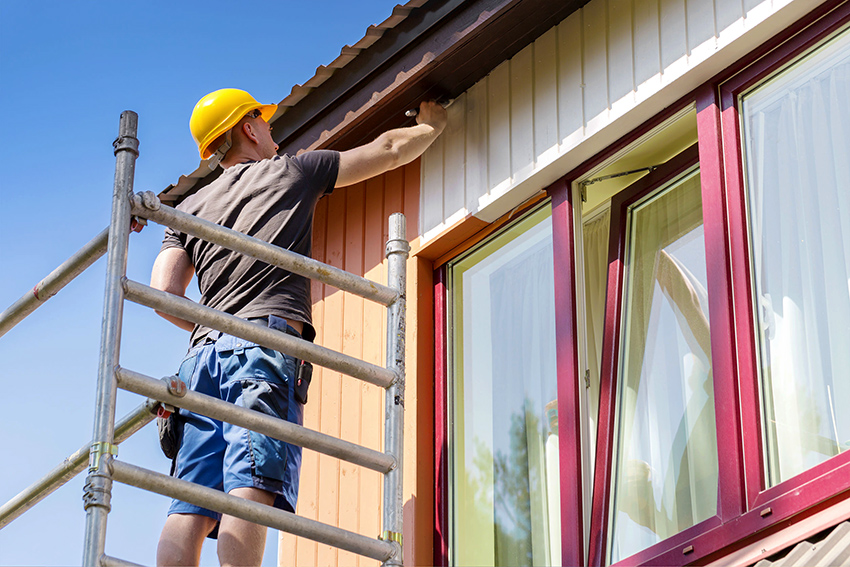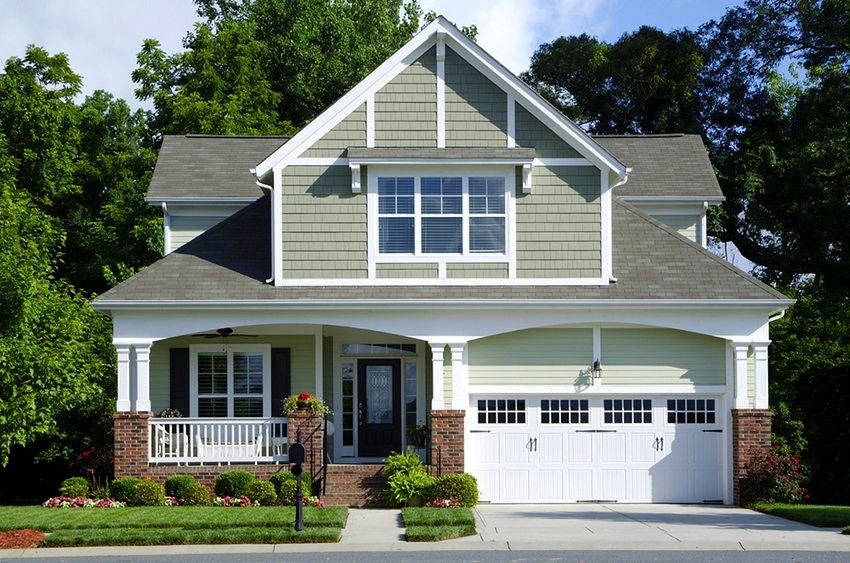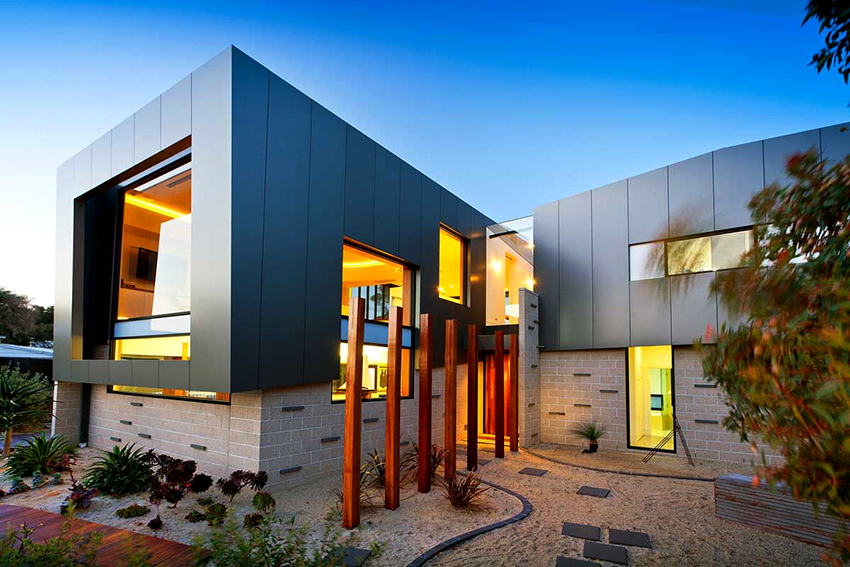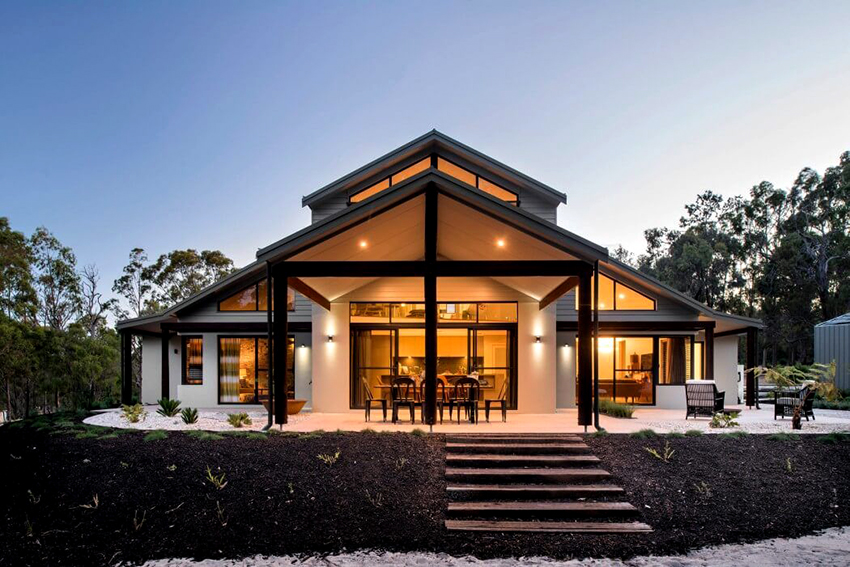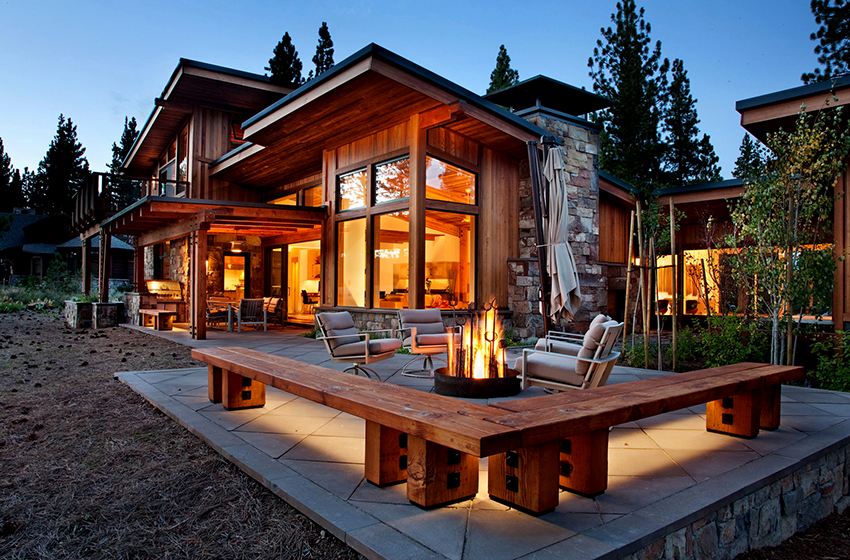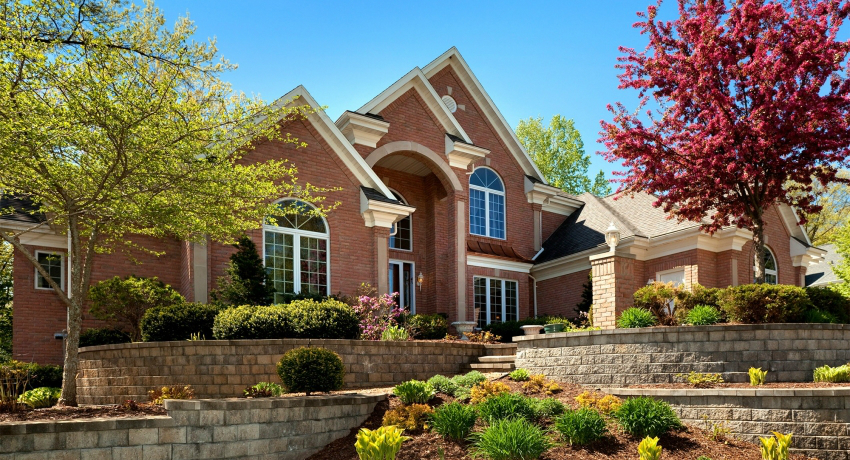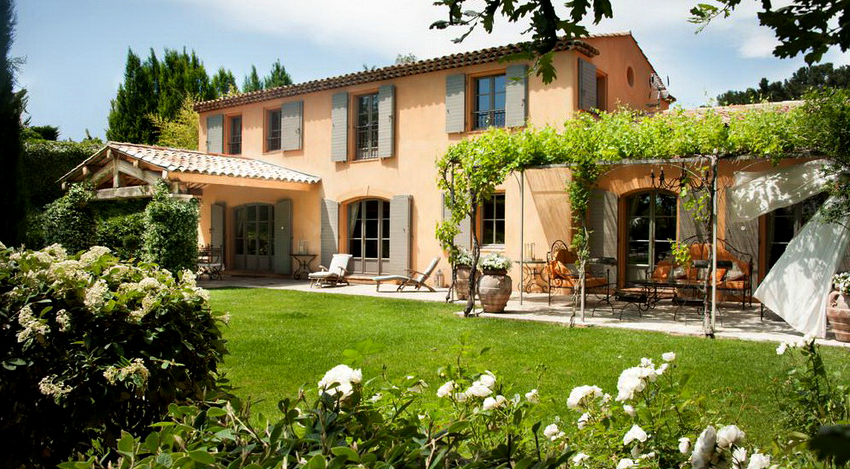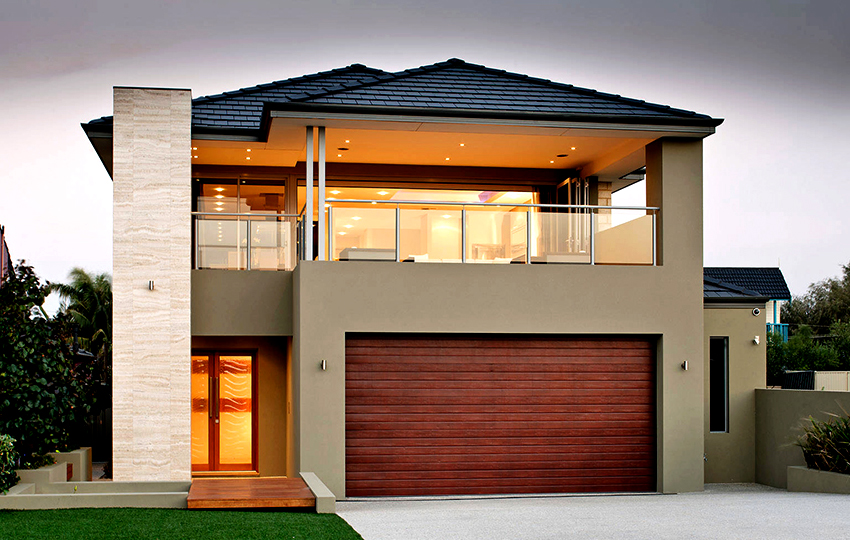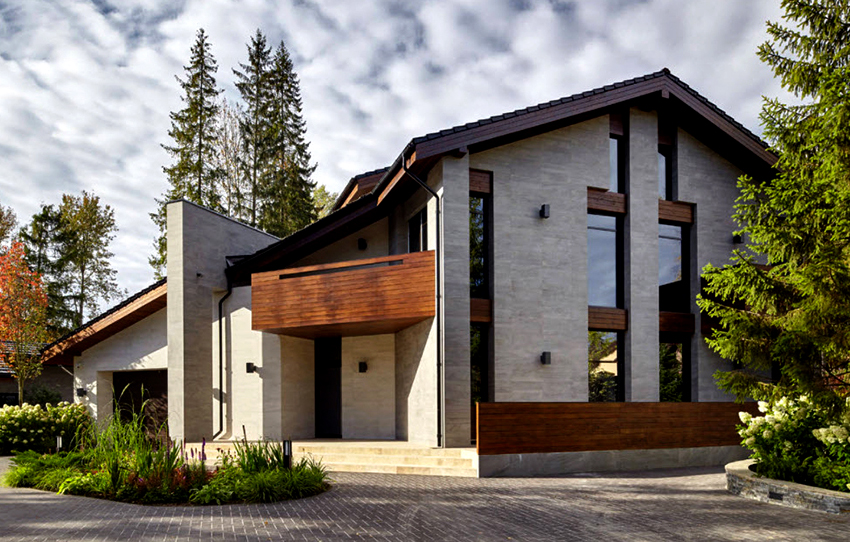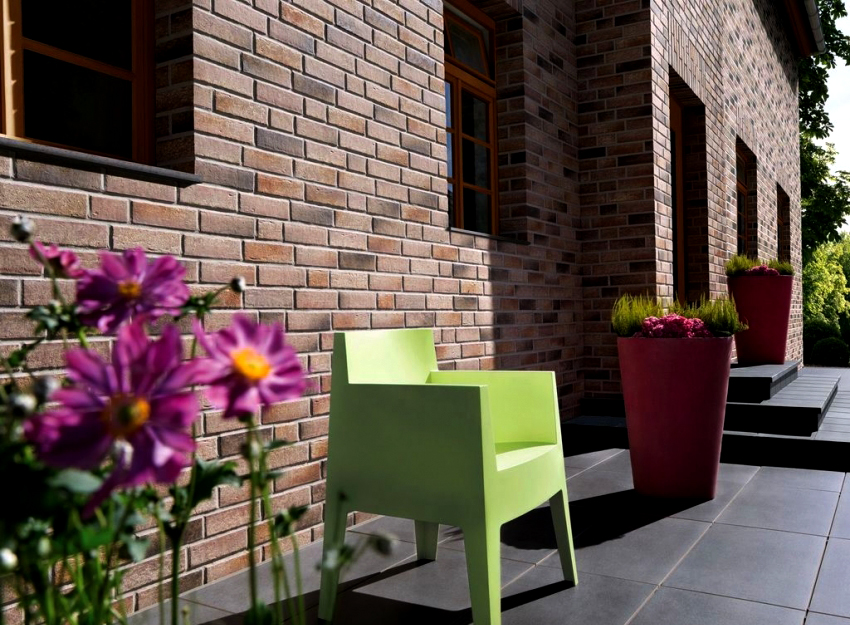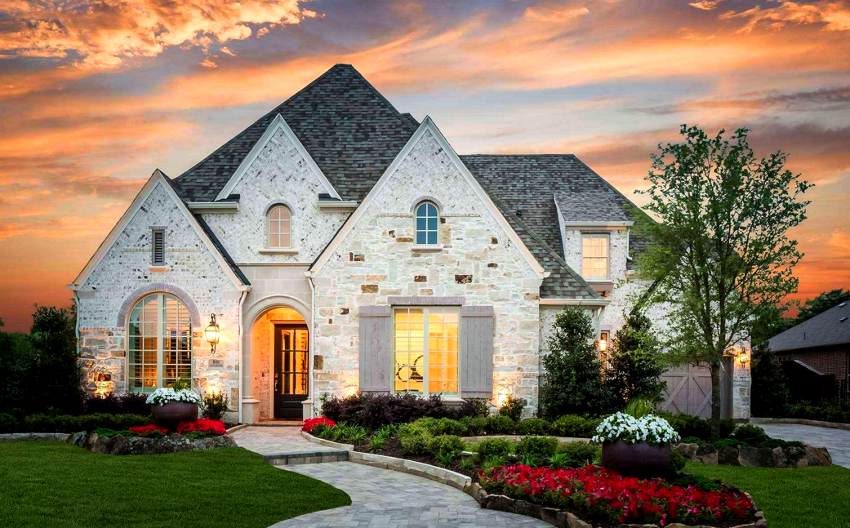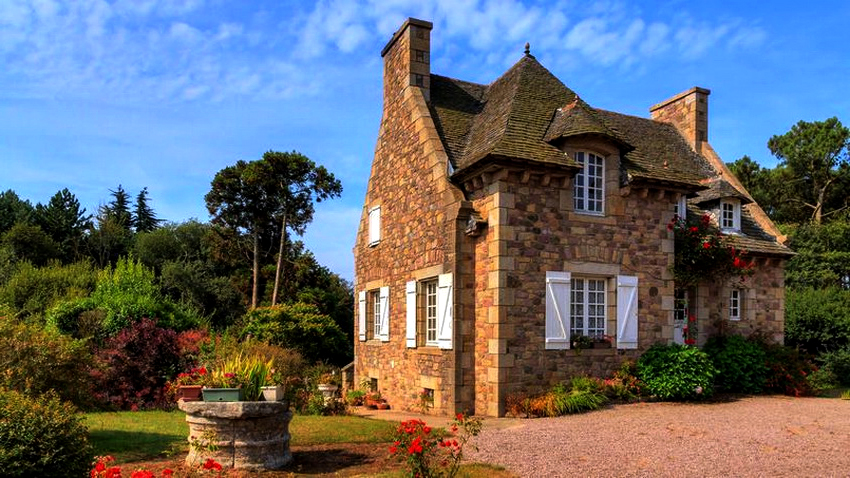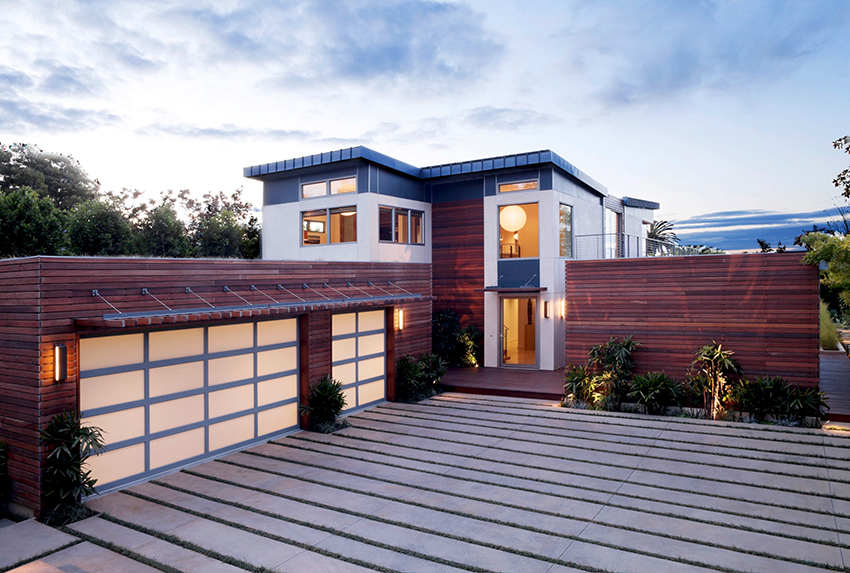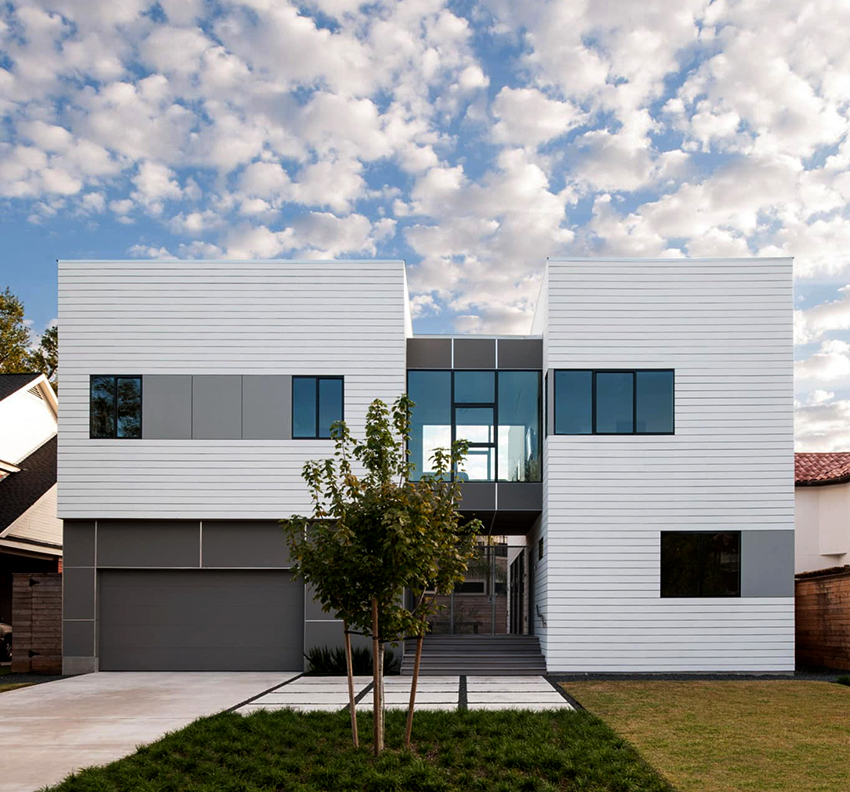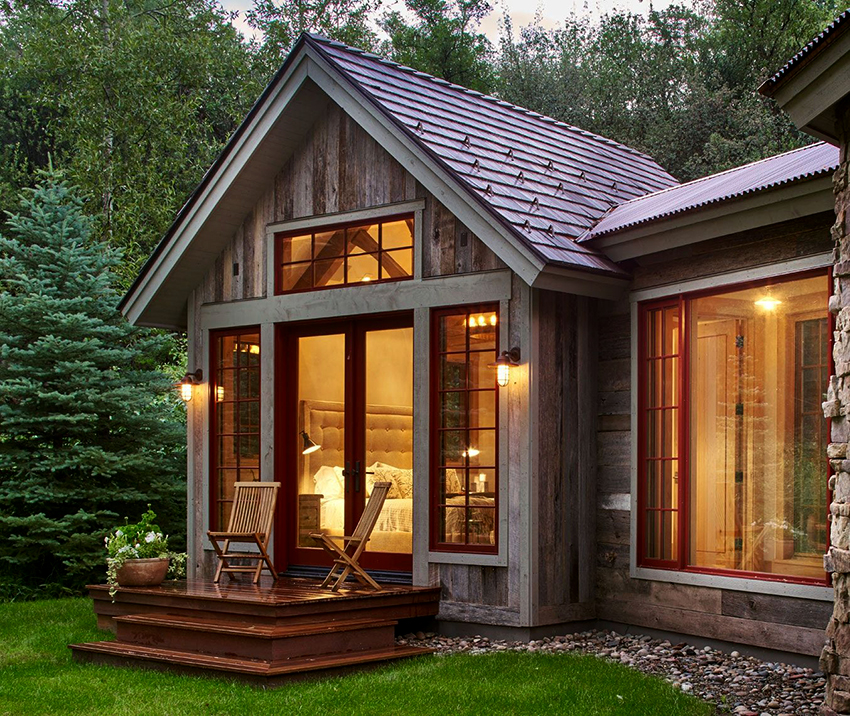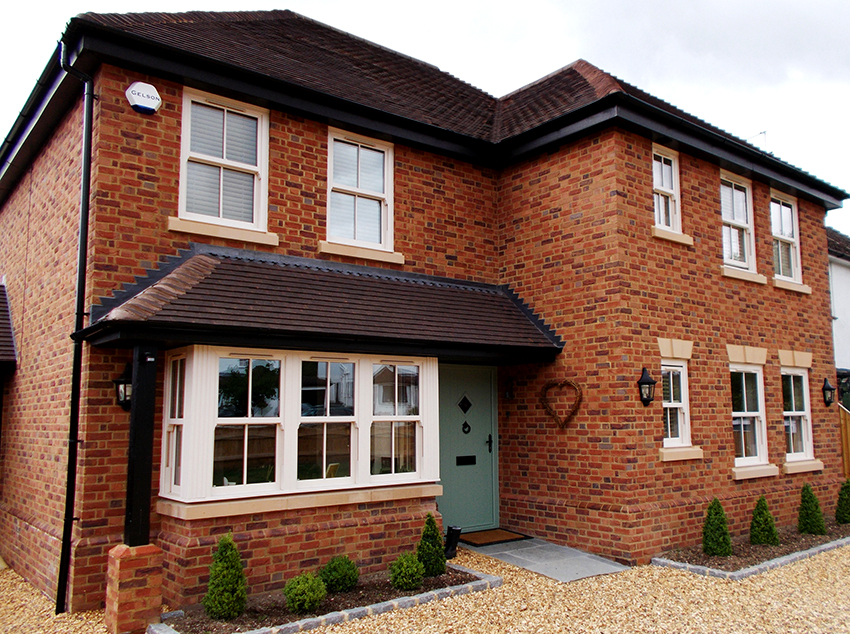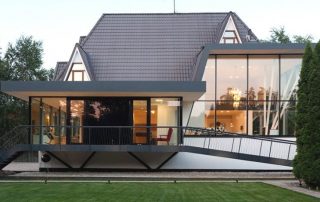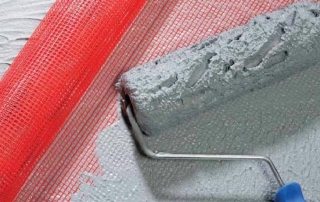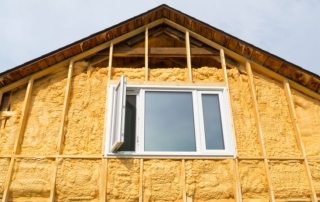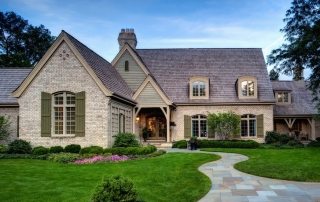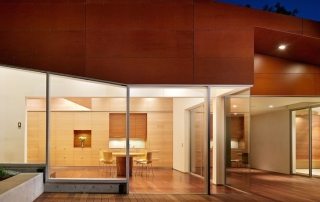If an inexpensive material with an unattractive appearance was used during the construction of the walls, you will need to finish the house outside. Thus, the facade will become attractive and stable, cracks and other flaws will be hidden. A properly selected coating will help protect wall surfaces from the harmful effects of external forces, prevent premature erosion and destruction. The attractive appearance of the building will always emphasize the status of the owners.
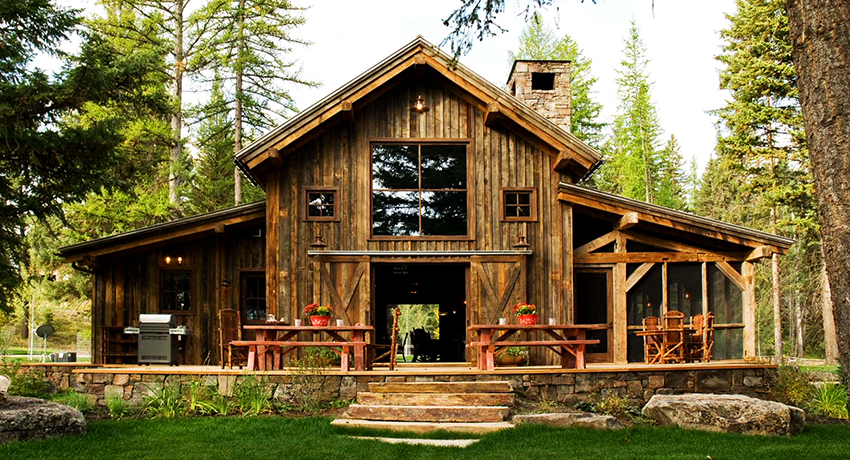
The facing material for the facade of the house must be of high quality and make the building attractive
Content
- 1 Why do we need exterior decoration of the house, its main purpose
- 2 When is it better to clad the finished building at home
- 3 How to sheathe a house: the choice of material for the construction of the frame
- 4 Reviews: the better to sheathe a wooden house and an arbolite building outside
- 5 Finishing the house outside: what material is suitable for the frame type of building
- 6 Plaster as one of the ways to decorate a house beautifully
- 7 How to sheathe the veranda and the house outside: brick as one of the options
- 8 Features of using natural stone for decoration: pictures of village houses
- 9 What is siding home decoration: types of material
- 10 Other Popular Options for Cladding External Building Walls
Why do we need exterior decoration of the house, its main purpose
The material for cladding the outside of the house should be selected at the stage of creating a building project. Exterior finishing can be used to reinforce the old façade and restore its neat appearance. If we are talking about the restoration of an old building, then the choice of material should be approached with greater responsibility, since it should not only look aesthetically pleasing, have quality characteristics, but also be compatible with the material from which the walls are made.
Important! The building material purchased for the construction of the box should be less permeable. This is necessary for the reason that the thermal insulation layer is considered less vapor permeable than the building material used for exterior wall decoration. Almost all materials have a low heat transfer index, except for natural wood.
If you choose a material for construction that does not differ in the required vapor permeability, most likely, condensate will accumulate at the boundaries of the layers. This will cause fungus to multiply, mold, and surfaces to rot. At low ambient temperatures, the leaked moisture will begin to freeze. This will lead to the expansion of small cracks and the slow destruction of the walls.An incorrectly executed facade will have to be changed after just a few years of operation. To establish air circulation inside the facade, you can use one of the following methods:
- Organize a ventilated facade. In this case, a permeable thermal insulation with ventilated gaps is laid between the wall and the finishing material. So, if we are talking about a facade of 20 m², including window and door openings, the volume of the gap must be at least 75 cm².
- Protect the inside of the wall with an additional vapor barrier. With this option, the facing material is attached directly to the wall of the house without any substrates. The inner layer prevents moisture from escaping to the surface of the wall and finishing.
After installing the ventilated layer, the top of the gaps remains open to allow vapors to escape. In this case, the decoration of a private house outside plays both a protective and decorative function.
With the advent of high-quality insulation materials for interior wall decoration, the second method of protecting walls has become much more common. Usually, expanded polystyrene is attached to the inner side, which is characterized by low vapor permeability and belongs to effective heat insulators. By insulating the inside of the wall with them, it will be possible to significantly save on heating the room. In such a situation, the facade can be clad with any material, be it a wooden beam or porcelain stoneware tiles.
When is it better to clad a finished building at home
Before choosing how to decorate the house from the outside, you need to decide at what stage of construction the preparatory work for installation will be carried out. The cladding should be carried out only after the door and window openings have been closed. It should also be borne in mind that the structure of any number of storeys is subject to shrinkage during the first year after construction. The higher the number of storeys, the more weight will affect the foundation. Sometimes the shrinkage reaches such values that the facade finish is damaged. Therefore, most experienced builders recommend to carry out facade work only one year after the end of the construction of load-bearing walls.
Helpful advice! It should be borne in mind that the wall decoration carried out at the wrong time can be damaged when fixing other building parts.
After a year, before starting the cladding work, you need to check the surface of the walls for vertical or horizontal distortions. If you find even minor violations at first glance, you need to fix them with plaster or lathing. Everything will depend on the material used to build the box and the chosen finish.
You should also not carry out facade work in the cold or too hot season. It is best to sheathe the building at an average daily temperature of 10 to 25 ° C. At such temperature indicators, building materials are in a normal state, do not undergo compression or swelling.
When choosing finishing materials, the original condition of the building must be taken into account. Some types of cladding are characterized by high weight, which will subsequently act on the foundation. This is especially true if an old house is being finished from the outside. In order to avoid trouble, it is better to contact a construction engineer who will be able to estimate the permissible additional load on an already finished base.
How to sheathe a house: the choice of material for the construction of the frame
The choice of exterior decoration options for the house depends on what kind of material was used to build the outer walls of the box.Most often, in the construction of country or private houses, preference is given to blocks, because as a result of their use, it is possible to significantly reduce the time for construction, as well as save financial resources. It is cheaper to build a house from blocks than if you choose brick or wood for this purpose.
Despite the fact that block houses are considered practical and affordable, their appearance requires mandatory improvement. Therefore, you should choose a suitable option for facing the house in order not only to extend the life of the building, but also to give it an aesthetic and complete look. With the help of finishing materials, it will be possible to mask all defects on the surface of the walls and significantly reduce heating costs, because block houses themselves are rather cold. Popular exterior finishes include:
- plaster;
- facing brick;
- tile;
- ventilated facade.
If plaster was chosen from the blocks to decorate the walls outside the house, it is recommended to pre-install a metal mesh on the entire facade area, which will improve the adhesion of the plaster mixture to the base of the building. The best option in this case is a galvanized mesh with a small link, mounted using self-tapping screws or nails with a bent head. The plaster should be applied in several layers. The finishing layer must be well leveled, and for decoration it is recommended to use special colors applied with spatulas.
Brick trim will cost a little more than plaster facing, but this material is considered more durable and practical. Hollow brick, which has high sound and thermal insulation performance, is suitable as a finish. Additionally, it should be borne in mind that facing bricks are more weight than plaster, so the foundation should be more powerful and wide. The facing stone can be laid both close to the base and with a gap, taking into account the thermal insulation layer of the foundation.
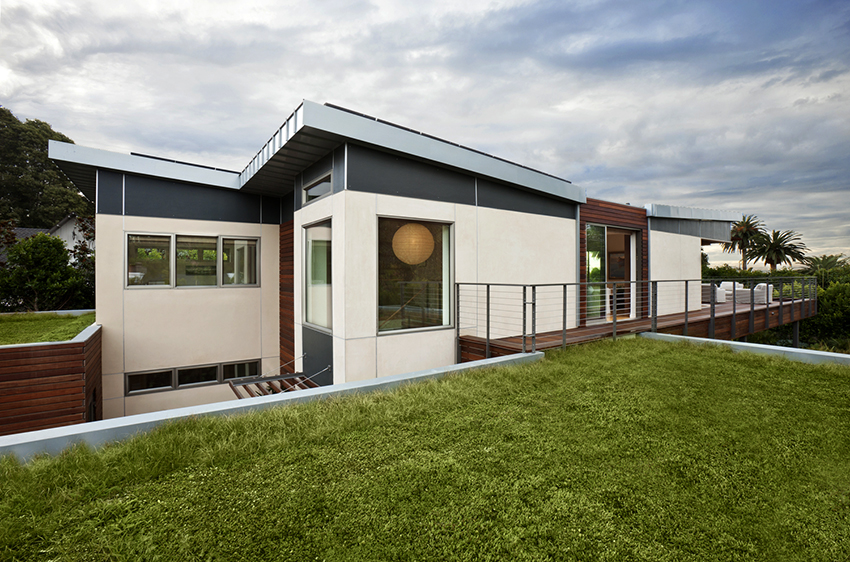
When choosing a facade finish, it is necessary to take into account the material from which the walls are erected
A ventilated facade is considered the best option for decorating a country house from the outside, if it is made of blocks. The design allows you to improve the thermal insulation qualities of the building and create the correct microclimate inside the house. Also, the ventilation façade makes it possible to use various material options for insulation and wall cladding.
Reviews: the better to sheathe a wooden house and an arbolite building outside
Before sheathing a wooden house, you need to understand that wood has the ability to "breathe" and also belongs to the most environmentally friendly materials that do not emit any harmful substances. But even in this case, you should not neglect the exterior finish, which will protect the base from fungus, rodents and decay. According to reviews, siding is often used to decorate a wooden house. By type of material, siding can be:
- metal;
- vinyl;
- wooden.
Any type of selected siding can mimic natural wood, stone, or have another attractive shade and structure.
According to reviews, the houses, for the construction of which wood concrete was used, are considered unique. They are lined in compliance with the basic rule - preservation of material properties. Arbolite itself is unstable to moisture, therefore, for finishing, you need to choose the facing option that can compensate for this shortcoming.
In this case, consumers consider plaster mixture the most successful material for cladding a house. Due to the rough surface of the wood concrete blocks, reliable adhesion of the plaster to the base is provided.In this case, it is not necessary to carry out additional preparation of the base. The only thing that needs to be done is to prime the base and apply a putty. Although some builders claim that it is possible to plaster wood concrete walls without putty, by installing a metal mesh using self-tapping screws.
If a ventilated facade was previously organized, then panels - siding or lining can be used to decorate the walls of the house from the outside. The simplest option for facade decoration is a polyurethane-based paint.
Finishing the house outside: what material is suitable for the frame type of building
Finishing the frame house from the outside gives rigidity to the structure and relieves some of the load from the frame. Before sheathing a house, you need to select a material with sufficient mechanical strength that can withstand compression and works well for bending. It is important that the walls retain their original shape as long as possible, regardless of the surrounding conditions. In addition, the cladding must withstand moisture, temperature extremes and the influence of various microorganisms. Other important requirements when choosing a material are considered to be simple installation and pliability to processing, especially if you plan to carry out the cladding yourself.
Helpful advice! Whichever panels are chosen for decorating the house outside, it is necessary that they lend themselves well to cutting and drilling. The material should not crumble or crack, and the panel must maintain its density at the cut point. Durability is also important so that you do not have to re-clad the house after 5-10 years.
For finishing a frame house, the following types of materials are most often used:
- moisture resistant plywood;
- cement-bonded particle boards (DSP);
- fibreboard (fiberboard);
- oriented strand board (OSB);
- edged board.
Finishing the house outside with OSB-plates is the most demanded in the construction of frame structures. The sheet consists of glued shavings and wood chips, which have a longitudinal arrangement in the outer layers, and transverse ones inside. As an adhesive mixture, synthetic resins and wax are used, which provide the finished board with water-repellent properties.
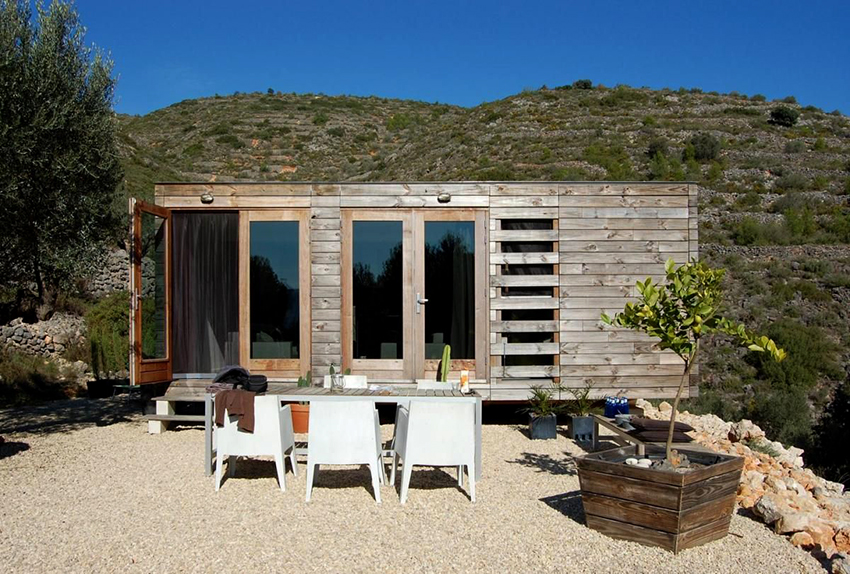
For the exterior decoration of a frame building, fiberboard, edged board, DSP, OSB and plywood are often used.
For external finishing, OSB-3 plates are used, which are distinguished by increased rigidity, moisture resistance, elasticity and the ability to withstand vibrations. The use of OSB boards will help to save money and sheathe the outside of the house cheaper than choosing another material. This is due to the fact that to give a more attractive appearance, it is enough to treat the surfaces with waterproof varnish or facade paint. Features of using other types of material for cladding a frame house outside:
- DSP. It is a compressed mass of cement and coniferous shavings. Differs in strength and long service life, it is considered an excellent base for plastering or painting. The stove is designed for 50 freezing and thawing cycles.
- Fiberboard. These are sheets of compressed shavings, during the manufacturing process they are very heated, which allows you to achieve maximum density without the use of adhesive mixtures. The natural resin in the shavings protects the material from mold. For cladding, sheets with a thickness of at least 2.5 cm are suitable.
- GVL. Moisture resistant material consisting of natural gypsum reinforced with cellulose fibers. Its high density makes it suitable for creating surfaces; sheets are attached to the supporting posts using self-tapping screws. To make the facade more attractive, it is covered with decorative plaster on top.
Plaster as one of the ways to decorate a house beautifully
Plaster has been used as a material for the exterior of a house for many decades. During this time, the material has become more refined. Houses with stucco facades not only look attractive, but are also durable and sustainable. With the help of a variety of modern plaster mixtures, relief patterns can be created on the surface of the walls. A thick layer of plaster reliably protects the walls from external influences and various kinds of damage.
Related article:
Clinker bricks for the facade: reliable and presentable building design
The history of the origin and the technology of manufacturing the product. Classification. Features of installation. Rating of popular manufacturers and the price of products.
Polymer plaster mix is made on the basis of water-soluble or polyvinyl acetate solutions, it can also consist of polyurethane and epoxy resin. The most common are acrylic plasters, which are characterized by high adhesion and elasticity. Due to the peculiarities of the composition and the presence of plasticizers in it, the applied plaster does not deform and does not crack after drying. These positive qualities allow the mixture to be applied to the facade immediately, because the material is not afraid of shrinkage.
It is interesting! Plaster is considered a versatile material for house cladding, because it can be applied to stone, block and concrete surfaces. You can also plaster a facade made of combustible materials. The main advantages are fire resistance, the ability to withstand high temperatures for a long time.
Another positive quality of this type of exterior home decoration is its versatility, since acrylic is suitable for any type of base: wood, brick, stone or concrete. Cons of using acrylic mix:
- Poor UV resistance. With constant exposure to the sun, the coloring substances in the plaster lose their properties and fade.
- Short service life compared to other types of cladding.
- Fast drying. The mixture sets very quickly, which can cause some difficulties for novice craftsmen who want to finish the country house outside with their own hands.
Other types of plaster used for exterior decoration of the house: photos of beautiful facades
Cement-based plaster is used for exterior decoration of brick houses, concrete buildings and blocks. The main components are cement, cleaned and well washed sand, as well as lime, which gives elasticity to the mixture. The composition also contains plasticizers and elements that give texture.
Helpful information! Cement mineral mixtures have good fire-fighting properties and have sufficient vapor permeability. Sold in the form of dry mixes, which, after opening the package, are mixed with water in the proportion indicated in the instructions.
The main advantages of using the material for finishing the house outside:
- environmental friendliness and natural composition;
- ensuring the protection of walls from external influences;
- lack of flammability;
- good heat-shielding and sound-insulating properties;
- compatibility with most building materials used for the construction of the box;
- long service life - about 50 years;
- low likelihood of cracks and other violations in the process of building shrinkage.
Before sheathing a brick house or a building made of other materials from the outside using cement plaster, it must be borne in mind that the material quickly sets and after mixing the solution, it must be used within 1-1.5 hours.In some cases, a finishing material will be required on top of the cement mixture, which will entail additional waste.
Silicone plaster is considered the highest quality option for facades, but the material is very expensive. In trading establishments, ready-made mixtures are mainly presented, which are sold in plastic buckets. The main positive aspects of applying silicone plaster:
- Good elasticity and adhesion to the surface, which greatly facilitates the application of the solution to the finished substrate.
- The ability to self-cleaning, because even in the rain, the main dirt is washed off the walls.
- Resistant to sunlight and long-term preservation of the facade color without fading.
- No cracks due to temperature changes.
It is permissible to apply silicone solution on any surface, including wood, which the plaster will protect from the growth of fungus or moss. The presence of fine-grained solid additives in the material makes it possible to form a beautiful relief on the facade.
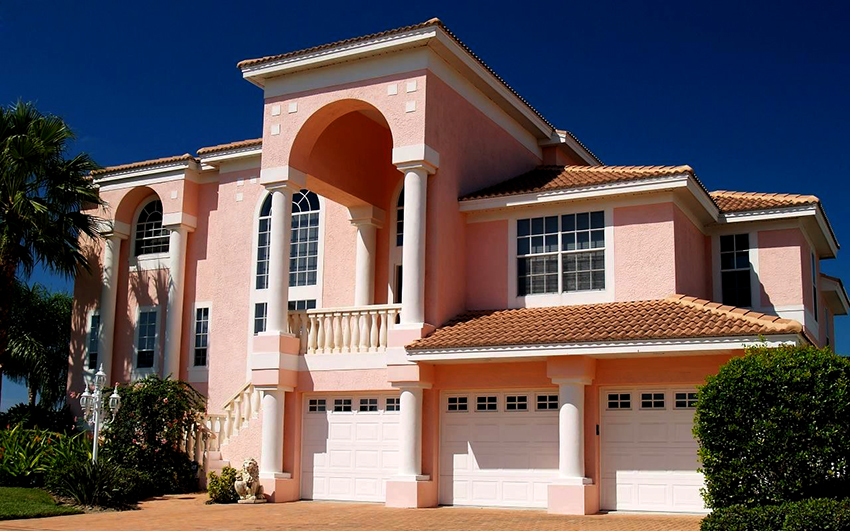
Acrylic plaster is considered the most versatile, as it is suitable for most types of base materials.
How can a house be sheathed? Another good option is a silicate plaster based on water glass, which contains mineral additives and coloring pigments. Solutions of various colors are sold ready-to-use. The environmental friendliness of the material ensures that there is no unpleasant smell and good vapor permeability together with water resistance. Compared to the previous version, it differs in a more affordable cost, while maintaining all the positive qualities. Its peculiarity is considered to be neutral electrostaticity, which prevents the deposition of dust.
How to sheathe the veranda and the house outside: brick as one of the options
Finishing the house outside with bricks is the only cladding option that is allowed to be done before installing window and door frames. This is due to the fact that this method provides for the construction of an additional solid wall layer, and the design of the openings will not be able to violate its integrity in any way. To ensure better thermal insulation of the building, a heater is laid under the cladding. It can be mineral wool, expanded clay or vermiculite backfill. There are the following types of facing bricks for facade decoration:
- silicate;
- ceramic;
- hyper-pressed.
In retail outlets there is a large selection of bricks of various shapes, sizes and shades. This allows not only to make the facade plain, but also to create an original drawing. Other advantages of using bricks for facade decoration:
- Reliable protection of the main walls from damage and good masking of the flaws of the original brickwork.
- Providing the building with additional heat and sound insulation.
- Fire safety due to resistance to extreme high temperatures and lack of flammability.
- The strength and durability of the material, with which only natural stone can be compared.
The main disadvantage of brick cladding is its significant weight, which makes the wall structure several times heavier, which, in turn, will affect the foundation. Therefore, it is recommended to plan this type of building cladding at the design stage of the house, taking into account the calculation of the resistance indicators of materials. If you look at photos of houses finished with bricks on the outside, you can notice that they look not only beautiful and aesthetically pleasing, but also expensive.
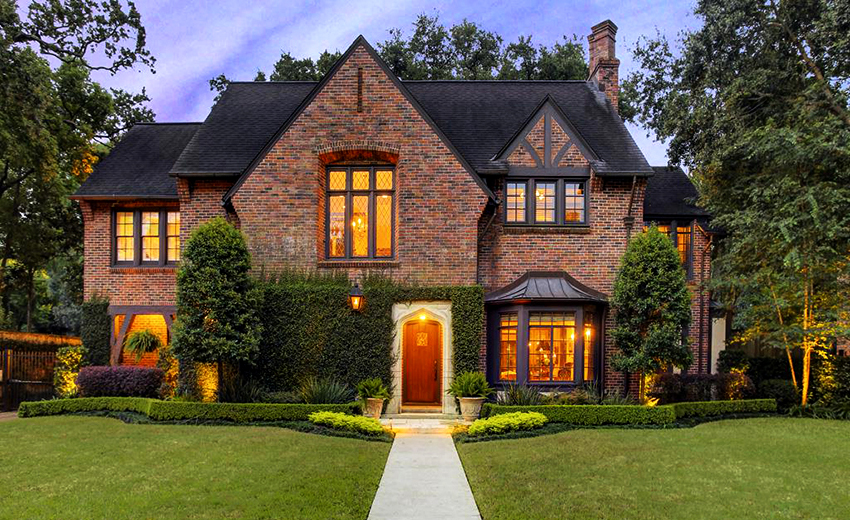
Facing the house with bricks must be planned at the design stage, since the material is heavy and this moment must be taken into account in advance
Helpful advice! If you plan to renovate the facade of an old house with bricks, it is better to carry out work to expand and strengthen the finished foundation.
Features of using natural stone for decoration: pictures of village houses
Natural stone is considered the most expensive cladding option, because its production requires a large amount of material and labor. But even despite the cost, it is this material that can be most often seen on the facades of houses, because the stone is distinguished by its versatility and durability.
A house finished with stone on the outside is not afraid of even large temperature amplitudes, does not change its shade under the influence of sunlight and is not exposed to humidity. If you follow all the rules for installing wall cladding, the cladding will not be damaged, which is a guarantee of durable use. For the manufacture of stone slabs, the following types of rocks are used:
- Sandstone. High strength stone, which is a separate part of sedimentary rocks. After processing, the stone takes the form of polygonal or rectangular slabs. To give an aesthetic appearance, each stone is ground.
- Limestone. It is considered the more common finishing stone due to its easy extraction. Limestone finish is distinguished by pleasant light colors, less often it is gray.
- Slate. In nature, it is formed when a rock mass is displaced and, in addition to wall decoration, is used as a roofing material. The downside of shale is its ability to delaminate along the fibers as a result of damage.
- Granite. A noble stone with the greatest strength and hardness. Due to increased wear resistance, it keeps a smooth surface for a long time and does not allow moisture to pass through. The main disadvantages are heavy weight and high cost.
- Labradorite. An unusual and beautiful stone, characterized by the presence of overflows on the cut surface. The facade of the house, made of labradorite, looks unusual, but at high temperatures, the stone can crack.
- Porphyrite. It is quite often used when decorating a basement. The stone is red and polished well. Rock parameters mainly depend on the place of extraction, but in any case, the slabs are resistant to mechanical stress and non-hygroscopic.
- Marble. The basis of the rock is calcite. Often inexperienced builders call limestone or dolomite marble, but unlike them, marble has a light shade and a large number of blotches of red, black or green. The material is characterized by a large number of advantages, but it is prone to yellowing of the surface, which spoils the appearance of the facade.
Helpful information! Having made the decision to use natural stone for finishing the facade, you need to take into account that you will need to pay a lot not only for the material itself, but also for its installation. However, a house beautifully decorated with natural stone will always emphasize the good taste of the owner.
How to sheathe a house from the outside: the advantages of finishing the facade with artificial stone
Artificial stone intended for decoration is produced by combining cement and gypsum with various additives. At the price, the material of artificial origin is much cheaper than natural, but thanks to modern technologies, it is not inferior in quality. The fact that artificial stone can perfectly imitate the natural structure and shade can be considered an advantage.
Another important advantage over natural stone is its lower weight, which will help to simplify the installation process and reduce the load on the base of the building.In addition to standard size parts, corner tiles are available for sale, with the help of which it will be possible to neatly decorate windows outside in a wooden house. The laying technology is similar to the process of wall cladding with ceramic tiles.
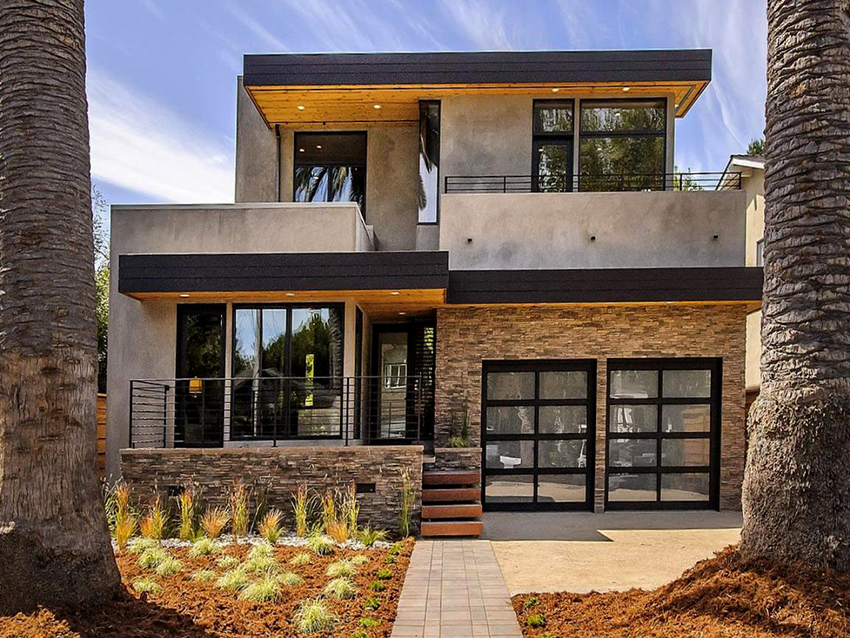
Artificial finishing stone is much cheaper than natural, while it is almost not inferior to it in terms of characteristics
Individual tiles of artificial stone differ in different shapes; they are made both in the form of tiles with the correct shape, and in the form of fragments of natural stone with chips and irregularities on the surface. If you follow the recommendations and lay the tiles in accordance with the technology, the masonry cannot be distinguished from natural. A significant disadvantage is the need for periodic touch-up of parts with facade varnish.
What is siding home decoration: types of material
Siding resembles a clapboard. They are distinguished only by the fact that one material is attached to the wall surface with an overlap, and the second - with the help of lock joints. Most often, the house is finished from the outside with siding made of aluminum, although vinyl and wood panels are also considered in demand.
Some options differ in the presence of a polymer coating of various tones, but panels that imitate a pattern of wood or stone are in the greatest demand. It is not uncommon to find outside the house a finish that imitates timber, which can only be distinguished from real wood on closer inspection. Due to the fact that each panel is laid on top of the previous one at a large slope, moisture flows freely from the surface without penetrating the main wall.
Helpful advice! Siding is available in single or double panels. To make the house look more attractive, it is recommended to use several different textures for decoration: the basement can be finished with stone siding, and the rest with a wood-like option. In the photo, houses sheathed with brick siding are indistinguishable from ordinary brick trim.
As for the prices of finishing the house with siding outside, it is worth noting that with the help of this material you can save a lot of money, because siding is cheaper than natural materials and it is much easier to fit. At the same time, the panels are distinguished by a long service life. Another advantage of siding is the ability to use it for cladding buildings from any material.
Before decorating a house with siding, you should familiarize yourself with the main types of this material. Vinyl sheets are made from high-tech polyvinyl chloride, which can be used at any temperature. The panels are easy to cut, which allows you to create the perfect appearance of the facade, even if there are protrusions and other decorative elements on the base.
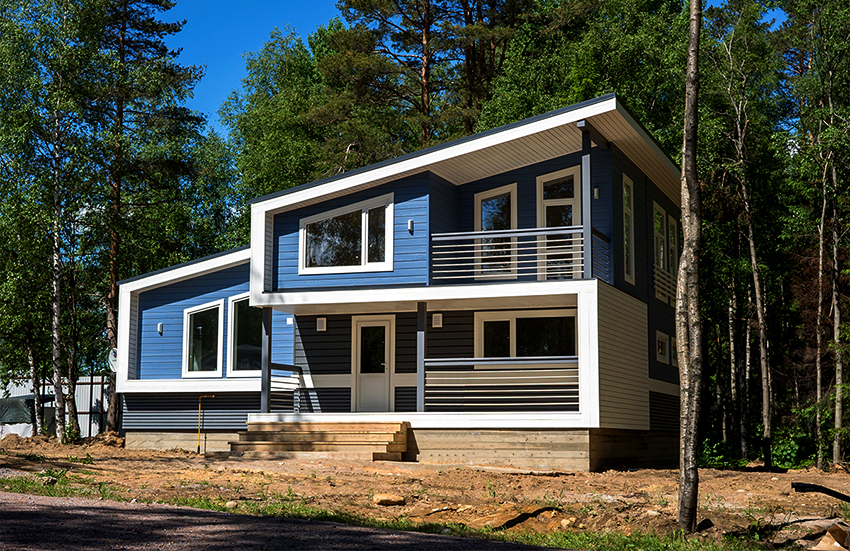
Siding is the most economical cladding option, since it is not expensive, and its installation is quite simple
Vinyl siding is lamellae, the thickness of which is 1-1.2 cm, and the width is 20-25 cm. It is mounted on a metal or wooden crate. To leave room for the possible movement of the lamella, it is not recommended to screw in the self-tapping screw with great force until it stops, it will be better if there is a slight backlash. For cladding the bottom of the building, it is recommended to take not the usual, but the basement type of siding, which has a large thickness. The main advantages of purchasing vinyl siding include:
- easy installation on buildings of any shape;
- low cost of panels;
- large temperature range at which installation can be carried out from -5 to +40 ° C.
Among the shortcomings, there is a rapid burnout under the influence of ultraviolet rays, therefore, light-colored panels should be preferred.Installation should not be carried out at non-recommended temperatures: if it is too cold, the siding sheets may crack during cutting, and in extreme heat, the sheets may bend.
Siding houses: features of metal slats
Metal siding, unlike vinyl siding, is made of galvanized steel or aluminum. After creating the workpiece, a coloring agent is applied to its surface, which protects the base from rust and corrosion. The lamellas are decorated in two ways:
- When using a polymer shell, it turns out to create a large selection of shades and colors. This type of siding does not fade and is not subject to mechanical stress.
- Coloring is carried out using the powder method. The lamellas are designed to operate under all conditions and temperatures. Even when heated, the paint does not flake or fade, and a large selection of colors and shades is available.
Installation of metal siding is carried out on the supporting and additional beams located on the side, using self-tapping screws and connecting locks on the strips. The main advantages are considered to be low cost and the ability to install under any conditions, because metal panels, unlike vinyl panels, are not so easy to spoil. The disadvantages include the relative simplicity of the facade due to the not very attractive appearance of the stripes.
Other popular material options for cladding external building walls
Wood is the material with the best vapor permeability. Decorating the house with wood from the outside is possible with solid walls made of any material. Thanks to the natural moisture release, moisture accumulation on the surface of the boards is prevented, and the inside of the wall always remains dry.
Helpful advice! If a house made of stone is sheathed with wood, a ventilation gap must be maintained between the wall and the cladding.
The main types of wood sheathing:
- Decorating the house with a block house from the outside will resemble a building assembled from rounded logs.
- A house clad with a plank imitating a timber will not differ from a building with a planed timber facade.
- Wooden lining is one of the most affordable natural materials for cladding.
- Planks, shingles, shindles and planks are small pieces of wood. For cladding the facade with these products, a significant amount of free time is required.
You can also decorate the outside of the house from a bar, which is dissolved into several parts. In this case, one should take into account the large weight of the structure after erection, the rather high cost of the material and expensive installation. The main disadvantages of using natural wood are flammability and susceptibility to the harmful effects of insects and small microorganisms. If the wooden facade is constantly treated with special mixtures, then it will last for many years without losing its appearance.
Thermal panels, consisting of two layers, are also popular in construction: the first is insulation, and the second is a decorative coating. The purchase of such material allows you to reduce the time for finishing the facade, since there is no need to separately insulate the walls, and reliable protection of the house box from external influences is provided. It can be used for all types of bases. Thermal panels are based on expanded polystyrene or polyurethane foam, and clinker, artificial stone, ceramics or porcelain stoneware acts as a decorative layer. Before choosing, you need to take into account that the price of thermal panels for exterior decoration of a house starts from 1200-1600 rubles per m².
By and large, any material used for finishing the facade is able to protect its surface from negative factors. It is important that the selected material not only looks attractive and ennobles the facade, but also creates a favorable microclimate in the house. To make your choice easier, you can preview photos of other buildings' finishes and find the perfect one for your home. It is important to approach the choice deliberately, because many types of facade materials are designed for 50 years of operation.
